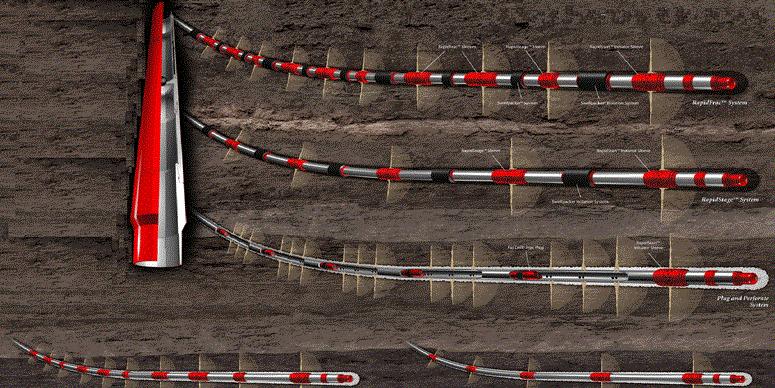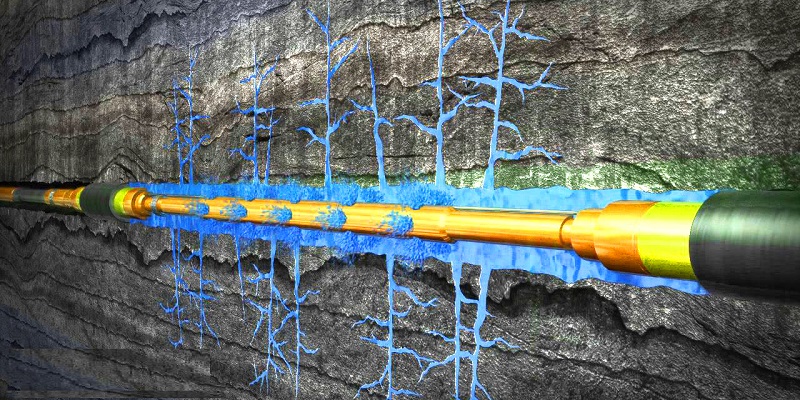Fracking Process Classification and Flow
Fracturing is to artificially produce cracks in the formation to improve the flow environment of oil in the subsurface, so as to increase the production of oil wells, which can play an important role in improving the flow conditions at the bottom of the oil wells, slowing down the interlayer and improving the mobilization of the oil formation.

After a certain stage of oil well production, the production capacity and permeability decrease, in order to enhance the oil drainage capacity and increase the oil well production, people invented the fracturing process technology.
Fracturing methods are divided into two categories: hydraulic fracturing and high-energy gas fracturing.
Hydraulic fracturing relies on the ground high-pressure pumping unit to inject fluids into wells at high speed, and with the help of high pressure held at the bottom of the wells, fracture is produced by rupture of oil formation rocks.
In order to prevent the pressure from dropping after the pumping truck stops working, and the cracks close up by themselves, in the injected fluid after the formation rupture, sand, which is several times denser than that of the formation, is mixed with the fluid and enters into the cracks, and stays in the cracks permanently to support the cracks in an open state, so as to improve the environment of the oil flow for a long time.
Currently, hydraulic fracturing technology is very mature and has become the preferred and commonly used technology to increase the production of oil wells.
It has become the preferred and commonly used technology, especially for the oil flow channel is very small, that is, the permeability of the bottom of the oil layer to increase production effect is particularly prominent.
According to different fracturing media, it is divided into
- Hydraulic fracturing:
Hydraulic fracturing, referred to as fracking, is an important technical measure for increasing the production of oil and gas wells and increasing the injection of injection wells.
It is to make use of high-pressure pumps on the ground to inject fracturing fluid into wells with a displacement that greatly exceeds the absorption capacity of the formation, causing high pressure at the bottom of the well and exceeding the stratum closure stress at the well wall and the tensile strength of the rock, so as to make the formation rupture and form a fracture, and then continue to inject liquid with proppant into the fracture, so as to make this fracture extend outward and fill the fracture with proppant, and then a sand-filled fracture of sufficient length and a certain width and height will be formed in the stratum after stopping the pump. After stopping the pump, sand-filled fracture with sufficient length and certain width and height will be formed in the formation.
2、CO2 foam fracturing
CO2 foam fracturing is to pump a mixture of liquid carbon dioxide and water-based fracturing fluid into the well and carry out fracturing to achieve the purpose of increasing production and injection. This technology is applicable to low-pressure and low-production gas wells, water-sensitive formations, extra-low permeability oil formations and thick oil wells.
According to the fracturing method is divided into:
- cage fracturing:
Cage fracturing is to lower the downhole tools, such as packer and sand blaster, into the upper part of the shot hole shot hole site to fracture the shot hole site, so as to achieve decongestion or modification of the target formation.
- Packer fracturing
Fracturing in layers by packer is realized by fracturing tubular columns in layers by packer, which is suitable for the transformation of high, medium, low permeability and multi-oil formations with small degree of non-homogeneity and small difference of water content between layers, and which have been routinely perforated.
3、Fracturing by flow restriction method
Fracturing by flow-limiting method is realized by low-density perforation injection and large-displacement fluid supply to form sufficient borehole resistance, so as to maintain high pressure in the wellbore, thus achieving the purpose of continuously fracturing some layers with similar fracture pressure.
4、Compound fracturing
Composite fracturing refers to the combination of high-energy gas fracturing technology, thermochemical process technology, acidizing process technology and hydraulic fracturing technology. This technology is suitable for the transformation of reservoirs with low temperature, under pressure, thick oil and high wax content.
5、Synchronized fracturing
Synchronized fracturing refers to the simultaneous fracturing of 2 or more paired wells. Simultaneous fracturing adopts the method of making the pressure fluid and proppant move from one well to another under high pressure for the shortest distance, so as to increase the density and surface area of hydraulic fracturing fracture network, take advantage of inter-well connectivity to increase the extent and strength of fracture in the working area, and maximize the connectivity of the natural fracture.
6、Hydraulic Jet Fracturing
Hydraulic fracturing is a hydraulic fracturing technology that uses high-speed and high-pressure fluids to shoot holes carrying sand bodies, and after opening the channel between the formation and the wellbore, the fluid displacement is increased so as to open fractures in the formation.

The relevant parameters involved include:
- oil and gas well parameters:
Fracturing well category, well diameter, downhole tubing (casing, tubing), wellhead device, cementing quality, location of injection well section, injection method, bullet type, phase angle, hole density and borehole size, downhole tool specification, size, rated pressure, withstand temperature and location.
- Oil and gas formation parameters:
Reservoir effective permeability, porosity, oil saturation, effective thickness, reservoir formation pressure, static temperature; reservoir oil-water phase permeability, fluid properties (density, viscosity, compression coefficient and total mineralization, etc.); rock mechanical properties (modulus of elasticity, Poisson’s ratio, compressive strength, etc.); vertical distribution of in-situ stresses in the reservoir and horizontal principal stresses orientation; lithology of the shielding layer, thickness and in-situ stress values, wells Oil test, development and production, production test and other information data.
- Fracturing parameters:
Fracture rupture pressure, extension pressure and closure pressure, data on the type of fracturing fluid, rheology, viscosity-temperature-viscosity-timing, filtration loss and damage, data on the type of proppant and its compressive strength, flow-conducting capacity and permeability of the fracture proppant layer, data on pumping displacement, average sand-liquid ratio, pumping procedure, power of fracturing equipment and its pressure limit, data on past fracturing practices in reservoirs and their production response before and after fracturing.


Follow Us